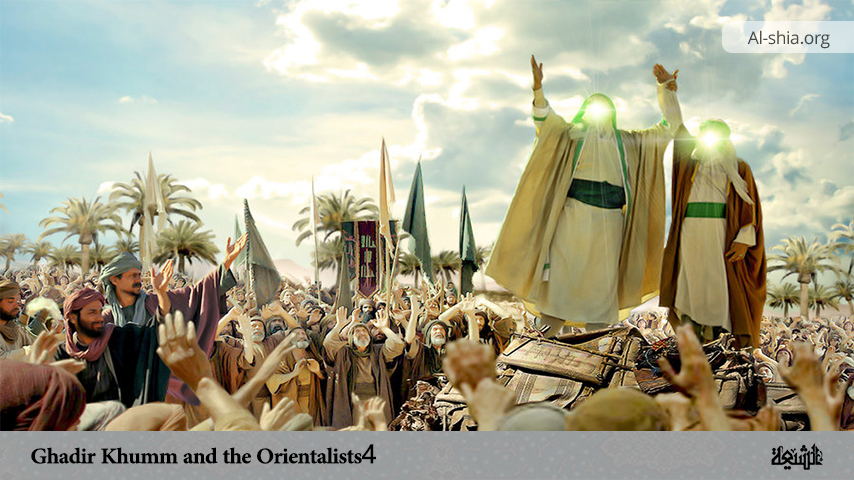In this article titled “Ghadir Khumm and the Orientalists”, we shall focus on other aspects of the topic here.
Shaban & His New Interpretation
Among the latest work by Western scholarship on the history of Islam is M.A. Shaban’s Islamic History AD 600-750 subtitled “A New Interpretation” in which the author claims not only to use newly discovered material but also to re-examine and re-interpret material which has been known to us for many decades. Shaban, a lecturer of Arabic at SOAS of the University of London, is not prepared to even consider the event of Ghadir Khumm. He writes, “The famous Shi’ite tradition that he [the Prophet] designated ‘Ali as his successor at Ghadir Khumm should not be taken seriously.”
Shaban gives two ‘new’ reasons for not taking the event of Ghadir seriously: “Such an event is inherently improbable considering the Arabs’ traditional reluctance to entrust young and untried men with great responsibility. Furthermore, at no point do our sources show the Madinan community behaving as if they had heard of this designation.”(1)
Let us critically examine each of these reasons given by Shaban.
1. The traditional reluctance of the Arabs to entrust young men with great responsibility.
First of all, had not the Prophet introduced many things to which the Arabs were traditionally reluctant Did not the Makkans accept Islam itself very reluctantly was not the issue of marrying a divorced wife of one’s adopted son a taboo among the Arabs? This ‘traditional reluctance,’ instead of being an argument against the designation of ‘Ali, is actually part of the argument used by the Shi’as.
They agree that the Arabs (in particular, the Quraysh) were reluctant to accept ‘Ali as the Prophet’s successor not only because of his young age but also because he had killed their leaders in the early battles of Islam. According to the Shi’as, Allah also knew about this reluctance and that is why after ordering the Prophet to proclaim ‘Ali as his successor (“O the Messenger! Convey what had been revealed to you…”), He reassured His Messenger by saying, “Allah will protect you from the people.” (2) The Prophet was commissioned to convey the message of Allah, no matter whether the Arabs liked it or not.
Moreover, this ‘traditional reluctance’ was not an irrevocable custom of the Arab society as Shaban wants us to believe. Jafri, in The Origin and Early Development of Shi’a Islam, says, “Our sources do not fail to point out that, though the ‘Senate’ (Nadwa) of pre-Islamic Mecca was generally a council of elders only, the sons of the chieftain Qusayy were privileged to be exempted from this age restriction and were admitted to the council despite their youth.
In later times more liberal concessions seem to have been in vogue; Abu Jahl was admitted despite his youth and Hakim b. Hazm was admitted when he was only fifteen or twenty years old.” Then Jafri quotes Ibn Abd Rabbih, “There is no monarchic king over the Arabs of Makkah in the Jahiliya. Therefore, whenever there was a war, they took a ballot among chieftains and elected one as ‘King’, were he a minor or a grown man. Thus on the day of Fijar, it was the turn of the Banu Hashim, and as a result of the ballot Al-‘Abbas, who was then a mere child, was elected, and they seated him on the shield.”(3)
Thirdly, we have an example in the Prophet’s own decisions during the last days of his life when he entrusted the command of the army to Usamah bin Zayd, a young man who was hardly twenty years of age. (4) He was appointed over the elder members of the Muhajirun (the Quraysh) and the Ansar; and, indeed, many of the elders resented this decision of the Prophet. (5) If the Prophet of Islam could appoint the young and untried Usamah bin Zayd over the elders of the Quraysh and Ansar, then why should it be “inherently improbable” to think that the Prophet had designated ‘Ali as his successor?
2. The traditional reluctance to entrust untried men with great responsibility.
Apart from the young age of ‘Ali, Shaban also refers to the reluctance of the Arabs in entrusting “untried men with great responsibility.” This implies that the Arabs selected Abu Bakr because he had been “tried with great responsibilities.” I doubt whether Mr Shaban would be able to substantiate the implication of his claim from Islamic history. One will find more instances where ‘Ali was entrusted by the Prophet with greater responsibilities than Abu Bakr. ‘Ali was left behind in Makkah during the Prophet’s migration to mislead the enemies and also to return the properties of various people which were given in trust to the Prophet (PBUH&HP).
‘Ali was tried with greater responsibilities during the early battles of Islam in which he was always successful. When the ultimatum (bara’at) against the pagan Arabs of Makkah was revealed, first Abu Bakr was assigned to convey it to the Meccans; but later on, this great responsibility was taken away from him and entrusted to ‘Ali. ‘Ali was entrusted with the safety of the city and citizens of Medina while the Prophet had gone on the expedition to Tabûk. ‘Ali was appointed the leader of the expedition to Yemen. These are just a few examples that come to mind at random. Therefore, on a comparative level, ‘Ali bin Abu Talib was a person who had been tried and entrusted with greater responsibilities than Abu Bakr.
3. The behaviour of the Medinan community about the declaration of Ghadir Khumm.
Firstly, if an event can be proved true by the accepted standard of hadith criticism (of the Sunnis, of course), then the reaction of the people to the credibility of that event is immaterial.
Secondly, the same ‘traditional reluctance’ used by Shaban to discredit the declaration of Ghadir can be used here against his scepticism towards the event of Ghadir. This traditional reluctance, besides other factors that are beyond the scope of this paper,(6) can be used to explain the behaviour of the Madinan community.
Thirdly, although the Medinan community was silent during the events which kept ‘Ali away from the caliphate, there were many among them who had witnessed the declaration of Ghadir Khumm. On quite a few occasions, Imam ‘Ali implored the companions of the Prophet to bear witness to the declaration of Ghadir. Here I will just mention one instance that took place in Kufa during the reign of Imam ‘Ali, about 25 years after the Prophet’s death.
Imam ‘Ali heard that some people were doubting his claim of precedence over the previous caliphs, therefore, he came to a gathering at the mosque and implored the eyewitnesses of the event of Ghadir Khumm to verify the truth of the Prophet’s declaration about his being the lord and master of all the believers.
Many companions of the Prophet stood up and verified the claim of ‘Ali. We have the names of twenty-four of those who testified on behalf of ‘Ali, although other sources like Musnad of Hanbal and Majma’ az-Zawa’id of Hafidh al-Haythami put that number at thirty. Also bear in mind that this incident took place 25 years after the event of Ghadir Khumm, and during this period hundreds of eyewitnesses had died naturally or in the battles fought during the first two caliphs’ rule. Add to this the fact that this incident took place in Kufa which was far from the centre of the companions, Medina. This incident that took place in Kufa in the year 35 AH has itself been narrated by four companions and fourteen tabi’in and has been recorded in most books of history and tradition. (7)
In conclusion, the behaviour of the Madinan community after the death of the Prophet does not automatically make the declaration of Ghadir Khumm improbable. I think this will suffice to make Mr Shaban realizes that he is not a ‘new’ interpretation; rather it exemplifies, in my view, the first stage of the classical response of the Sunni polemicists-an outright denial of the existence of an event or a hadith which supports the Shi’a view-which has been absorbed by the majority of Western scholars of Islam.
Continued in the next article: ( http://Ghadir Khumm and the Orientalists 5 )
NOTES:
_________________________________________
1. Shaban, Islamic History AD 600-750 (Cambridge: University of Press, 1971) p. 16.
2. (5:67)
3. Jafri, S.H.M., The Origin and Early Developments of Shi’a Islam, p. 22.
4. Haykal, M.H., Hayat Muhammad (2nd edition) p. 478; also see its translation, The Life of Muhammad, tr. al-Fa’ruqi (n.p.: American Trust Publications, 1976) p. 492.
5. See Ibn Sa’d’s at-Tabaqat and other major works on sirah.
6. For more details, see Rizvi, S.S.A., Imamate, p. 120-121.
7. For full references, see al-Amini, al-Ghadir, vol. 1 (Tehran: Mu’assasatu ‘l-Muwahhidi, 1976) p. 166-186.


















